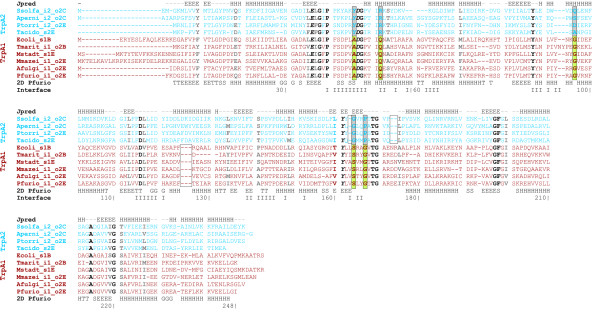Figure 6.

Multiple sequence alignment of TrpA sequences. Ssolfa_i2_o2C, Aperni_i2_o2C, and Ptorri_i2_o2C represent TrpA sequences from i2_o2 species possessing both an operon-based and a non operon-based trpB2. Tacido_s2E represents a species having exclusively an operon-based trpB2. Ecoli_s1B and Tmarit_i1_o2B represent bacterial TrpA proteins. Mstadt_s1E is from a species possessing exclusively an operon-based trpB1 gene, Mmazei_i1_o2E, Afulgi_i1_o2E and Pfurio_i1_o2E are TrpA sequences from i1_o2 species possessing an operon-based trpB1 and a non operon-based trpB2 gene. Presumably, these TrpA1 proteins interact with a protein of type TrpB1. Below the alignment, the 2D-structure of TrpA of P. furiosus (Pfurio_i1_o2E), and residues involved in protein interaction with its TrpB1 (I) are given. The line named Jpred lists a 2D-prediction of Ssolfa_i2_o2C generated by using the Jpred server [37]. Residues printed in bold are conserved; black residues are strictly, grey residues are less strictly conserved. Active site residues are plotted in italics. These data were deduced from the PDBsum pages [56] and the PISA server [58] of the EBI. Residues printed in boxes were predicted by SDPpred [38] as being specific for the two TrpA species.
